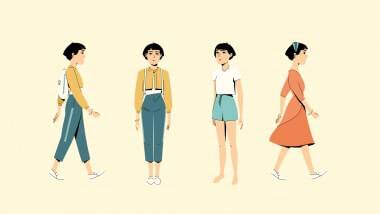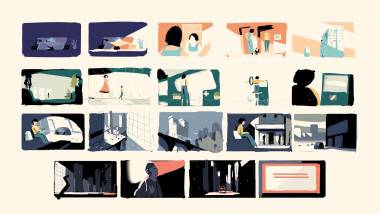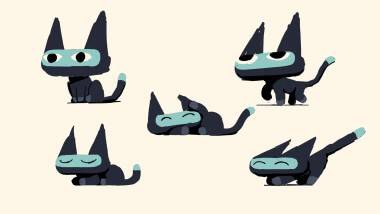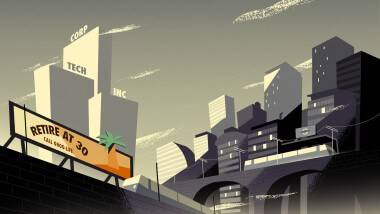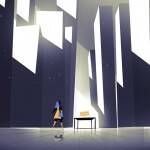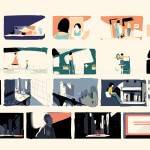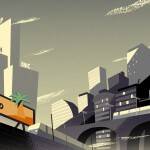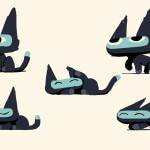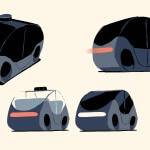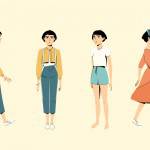Moth Collective Deliver The Last Job on Earth – Interview
Moth Collective, the London based consortium of RCA alumni set up by Daniel Chester, Dave Prosser and Marie-Margaux Tsakiri-Scanatovits have recently released The Last Job for The Guardian. The short, informative piece manages to immerse the viewer in a wonderfully constructed vision of the future that is tinged with a hint of darkness in order to deliver a cautionary tale for the paper.
One of the many notable achievements the short has to its name is the way it plays like a short film when it is essentially a corporate job. This allows Moth Collective to retain high quality, sharp designs and an engaging style throughout the run time, something which the studio has established as their style.
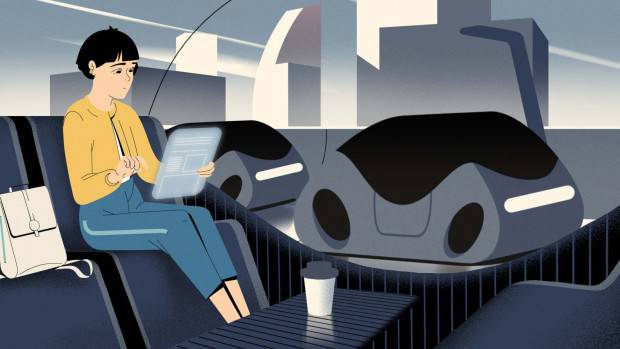
We caught up with Moth Collective co-founder Dave Prosser (Matter Fisher) who shares some exclusive behind the scenes images from the short with us and talks about bringing the future to life. Click on the images to see each one in their full glory.
Did the members of Moth Collective have defined roles on the short? Who generally does what?
Alice Design
Here at Moth we always work together as a unit to produce, direct and design everything we put out. Moth is made of 3 directors and 1 producer. Working together as a 4 brained, 8 winged beast allows us to share the pressures of any project and call upon our individual strengths throughout.
We have been functioning as a collective since 2010, recently becoming a full-time studio in 2015, so we have had time to construct a formula in which we work all well together! The most important thing about our relationship is that we can talk freely and there is a healthy amount of competition and drive between us that keeps us wanting to try new things and evolve. Time has also allowed us to develop a collective design aesthetic that feels compatible with our own individual voices. Although someone might take the lead in storyboarding or design phase we will all collectively contribute to the work.
How were you approached by the Guardian commissioning team to work on the short, was it purely for informational purposes?
Well the film is part of a year long exploration of new economic models by the Guardian’s Sustainable business team. We were asked to pitch on the short film and brought in at an early stage to have input into the script. As this was an ambitious project for the Guardian team, in terms of its content and schedule, it was important we were there from an early stage to make sure we could fit the content into 2 minutes.
Colour Script
It looked like you had fun with the concepts in the short, robot cats, automated hospitals etc, where did you start with those ideas?
The general outline for those points came directly from the Guardian editorial team. There were important key points and editorial facts to squeeze into the film but we were given the creative freedom to elaborate on these. The Catbot for instance felt more realistic than say a robot gorilla, which was originally mentioned. Our animations often play with the negative space on screen and fractured images reconstructing so creating such a full, rich world was ambitious for us but rewarding. We had discussion with the Guardian about the pharmacy no prescription cheap drugs us online pharmacy buy generic medications scene and how we felt that it was more powerful if we removed all of the background and placed her in a void for when she looks for assistance. We were pleased with the emotional impact of this scene, as its kind of the pivot point of the film which references our previous work yet doesn’t break the reality in which Alice exists.
As well as gadgets you also had to craft a society where this would all fit into, did you read up on futurists or read much Arthur C. Clarke?
Catbot Design
We’re all mega Sci-fi fans here at Moth so it was a dream to make a mini Sci-Fi. We’re fairly well versed in J G Ballard, Arthur C Clarke, Philip K Dick, Margaret Atwood and such, and obviously huge fans of 2001: A Space odyssey. There’s also a copy of Neuromancer that keeps appearing and disappearing from desks…
The design itself is a skilful mix of bold but also quite textured and graphic, was there a starting point there.
We wanted to keep the design in-tune with our collective
City Design
aesthetic as a studio but attempt something new. We usually use textures to accompany our digital work to help it feel a little warmer and more human. However, as we were building a ‘near future’ reality there needed to develop a utilitarian coldness to the way things were designed yet still keep them interesting and engaging. We made much of these design decisions in the storyboarding, making composition simple and bold to focus our attention on the story. Being sci-fi in nature, there was a temptation to add detail but we quickly realised the absence of the detail made everything feel slicker and more minimal. That meant when we employed more texture in the ‘old town’ scenes of the film there was greater contrast, creating a more gritty and ‘real-world’ feel. We also developed a colour script that evolves throughout the film, going from warm to clinical, becoming cooler and darker with higher contrast toward the end, accenting Alice’s emotional journey throughout.
Do you feel commissions like this give companies like Moth the ability to create works of art in Lieu of any funding or external support for independent short filmmaking?
It was a rare treat to be given such a open script and a rich world to interpret, so naturally we jumped at the opportunity to bring it to life. Throughout production it did feel as if we were creating our own short film and we became very attached to our ideas. The Guardian were very hands off throughout and trusted our instincts as filmmakers, having such creative freedom and belief from a client can make a big difference to the final film.
- Server Design
- Colour Script
- City Design
- Catbot Design
- Car Design
- Alice Design
- Alice Design
To see more of the work of Moth Collective check out their Facebook, Twitter, Vimeo or their website.


